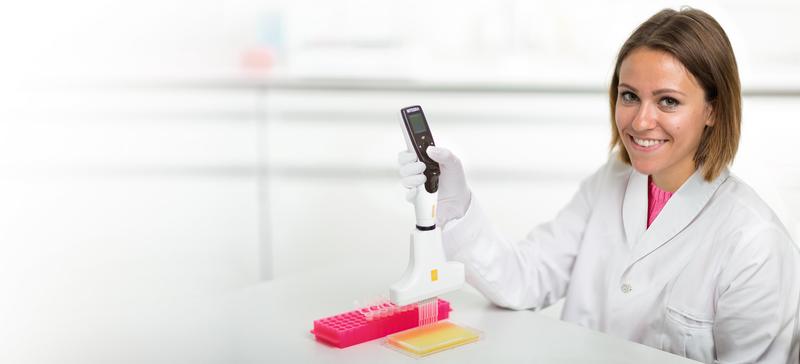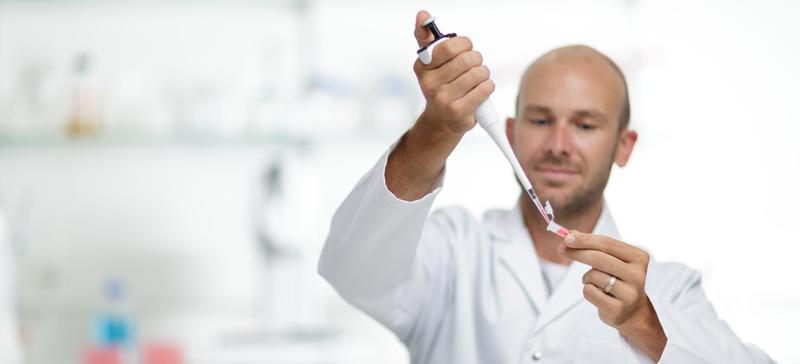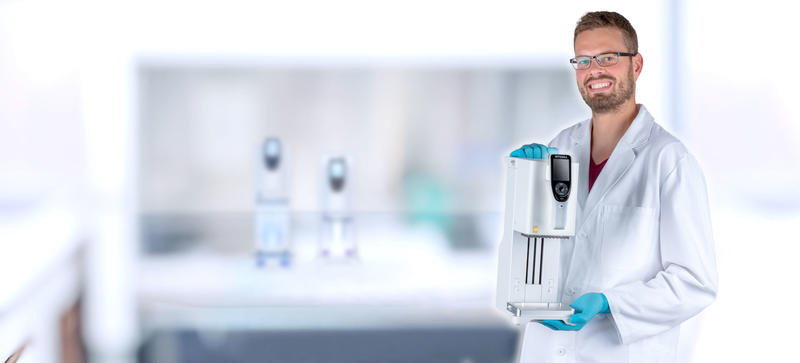-
Western blot protocol automation with the ASSIST PLUS pipetting robot and Simple Western™
Foolproof Jess plate set-up with D-ONE
Automated western blotting is a cutting-edge technology revolutionizing traditional protein detection and analysis. Employing robotic systems, microscale separation, and advanced imaging technologies streamlines the labor-intensive and time-consuming process of western blotting. Automating the multiple workflow steps increases efficiency, making it an invaluable tool in various fields of biological research.
Simple Western – developed by ProteinSimple, a Bio-Techne brand – is the only fully automated western blotting solution on the market. The advanced, capillary-based technology enables efficient and accurate high throughput protein separation, detection and quantification, with all assay reagents and samples in one plate. Simple Western assays are advancing research and development in many applications, including cancer and immuno-oncology, cell and gene therapy, regenerative medicine and targeted protein degradation.
Benefit from 100 % hands-free time without worrying about tedious liquid handling. Effortlessly fill plates specifically designed for Simple Western instruments – like Jess™ or Abby™ – with the ASSIST PLUS pipetting robot and D-ONE single channel pipetting module. Our protocols automate the Simple Western plate set-up for chemiluminescence detection of single target, multi-target (using RePlex™) or total protein assays. We demonstrate fully automated liquid handling of all 3 assay types by performing chemiluminescence detection and total protein analysis in one RePlex normalization assay. The results show equivalent performance to manual plate filling, with comparable on-deck sample and reagent stability.
-
Table of contents
Automated western blotting is a cutting-edge technology revolutionizing traditional protein detection and analysis. Employing robotic systems, microscale separation, and advanced imaging technologies streamlines the labor-intensive and time-consuming process of western blotting. Automating the multiple workflow steps increases efficiency, making it an invaluable tool in various fields of biological research.
Simple Western – developed by ProteinSimple, a Bio-Techne brand – is the only fully automated western blotting solution on the market. The advanced, capillary-based technology enables efficient and accurate high throughput protein separation, detection and quantification, with all assay reagents and samples in one plate. Simple Western assays are advancing research and development in many applications, including cancer and immuno-oncology, cell and gene therapy, regenerative medicine and targeted protein degradation.
Benefit from 100 % hands-free time without worrying about tedious liquid handling. Effortlessly fill plates specifically designed for Simple Western instruments – like Jess™ or Abby™ – with the ASSIST PLUS pipetting robot and D-ONE single channel pipetting module. Our protocols automate the Simple Western plate set-up for chemiluminescence detection of single target, multi-target (using RePlex™) or total protein assays. We demonstrate fully automated liquid handling of all 3 assay types by performing chemiluminescence detection and total protein analysis in one RePlex normalization assay. The results show equivalent performance to manual plate filling, with comparable on-deck sample and reagent stability.
Key benefits
- Full walk-away western blot protocol automation combines the ASSIST PLUS pipetting robot with the D-ONE single channel pipetting module and Simple Western Jess. On top of that, the user benefits from VIALAB's flexible use to create sample preparation protocols for ASSIST PLUS.
- Foolproof liquid handling and plate filling with D-ONE's liquid level detection (LLD) and automated GRIPTIPS® pipette tips selection, ensuring precision and accuracy for both low and high volume transfers.
- VIALAB's labware tool simplifies the labware definition for unique plates and D-ONE works well, even with uneven well distributions.
- Simple Western’s advanced capillary electrophoresis immunoassay technology enables reliable, high throughput, automated western blot analysis of up to 24 samples per run, with results ready in as little as 3 hours.
- Simple Western’s chemiluminescence and NIR/IR fluorescence detection provide flexible multiplex analysis capabilities, and ensure high sensitivity when working with precious samples or low abundance targets. RePlex enables 2 immunoassays in a single capillary, and even provides total protein detection to accurately normalize protein expression data.
- The small footprint of the ASSIST PLUS and Jess instruments save space so they fit easily into any laboratory.
Overview: How to fill the Simple Western Jess plate with ASSIST PLUS
The ASSIST PLUS pipetting robot and D-ONE single channel pipetting module, together with the Simple Western Jess, automate all the liquid handling steps required to analyze 24 samples, providing a complete walk-away solution for western blot protocol automation.
The whole workflow consists of 2 steps (Figure 1):
- Simple Western Jess plate filling with D-ONE and ASSIST PLUS
- Protein analysis with Simple Western
This application note provides Jess plate filling protocols for chemiluminescence detection of single targets, multiple target (using RePlex) and total protein analysis of prepared samples and reagents for reliable downstream protein analysis using Simple Western.
Downloads: App note and protocols for Jess plate set-up with the ASSIST PLUS pipetting robot
Plate set-up for RePlex chemiluminescence western blot protocol automation
Experimental set-up:
Position A: Wash buffer (blue)
Position B: B1 – antibody diluent (lavender), streptavidin-HRP (red), luminol-peroxide mix (yellow), RePlex mix (pink); B2 – primary antibody probe 1 (light green-1), secondary antibody probe 1 (green-1), primary antibody probe 2 (light green-2), secondary antibody probe 2 (green-2); B3 – biotinylated ladder (violet); B4-B6 – prepared samples (orange, arrow indicates processing direction)
Jess plate set-up for RePlex
Place a 25 ml reservoir on deck position A and fill it with at least 8 ml of wash buffer. Place the INTEGRA tube rack on position B with the specific reagent and sample tubes, as indicated in the experimental set-up. As shown in Figure 2, the Jess plate is in landscape orientation on position C. LLD enables the use of different aliquot sizes, and D-ONE informs the operator if the liquid volume is insufficient.
Equip ASSIST PLUS with the 0.5-300 µl D-ONE, and run the VIALAB program 'Jess_plate_setup_RePlex'. D-ONE and ASSIST PLUS with 12.5 µl long, sterile, filter GRIPTIPS transfers 10 µl of antibody diluent from a 2 ml tube in position B1 (Figure 2, lavender) to wells B1-B25, C1, E1 and F1 of the Jess plate (Figure 3) in position C. A 1 µl pre- and post-dispense guarantees precise pipetting while preventing bubble creation during dispensing. By automatically changing GRIPTIPS between different reagents or samples, D-ONE transfers 10 µl of primary antibody probe 1 from a 1.5 ml microcentrifuge tube in B2 (Figure 2, light green-1) to wells C2-C25 (Figure 3) of the Jess plate in position C (Figure 4a). From the second 2 ml screw cap vial in B1 (Figure 2, red), D-ONE transfers 10 µl of streptavidin-HRP/NIR to well D1 (Figure 3). Wells D2 to D25 (Figure 3) are filled with 10 µl secondary antibody probe 1 from a 1.5 ml microcentrifuge tube in B2 (Figure 2, green-1). 10 µl primary antibody probe 2 from position B2 (Figure 2 , light green-2) is transferred to wells E2 to E25 (Figure 3), and 10 µl secondary antibody probe 2 from B2 (Figure 2, green-2) is transferred to wells F2 to F25 (Figure 3).
With 300 µl sterile, filter GRIPTIPS, D-ONE transfers 500 µl of wash buffer (Figure 2, blue) from the 25 ml reservoir on position A to the Jess plate compartments in 2 steps (Figure 4b), as indicated in Figure 3. A slow speed (5) prevents bubble creation during buffer dispensing. Afterwards, 170 µl of luminol-peroxide mix is transferred from the 2 ml tube in B1 (Figure 5, yellow), and 300 µl of RePlex reagent mix from another 2 ml tube in B1 (Figure 5, pink) to the compartments indicated in Figure 3. D-ONE then transfers the RePlex reagent mix in 2 steps, with a pre- and post-dispense of 10 µl to prevent bubble creation during dispensing.
5 µl of biotinylated ladder is transferred from a 0.5 ml microcentrifuge tube in position B3 (Figure 2, violet) to well A1 (Figure 3). As indicated by the arrow in Figure 2, D-ONE transfers 3 µl of prepared sample (Figure 2, orange) from each 0.5 ml microcentrifuge tube in positions B4 to B6 (Figure 2, orange) to wells A2-A25 (Figure 3). Fast dispensing (speed 10) increases the accuracy for small volumes. The pipette then instructs the user to centrifuge the plate for 5 minutes at 2500 rpm, before proceeding with Simple Western Jess protein separation and immunodetection.
Tips:
- It is possible to work with very low volume inputs (5 µl) for precious samples, thanks to the D-ONE module's broad volume range.
- A prompt can be included in the protocol before starting with the sample transfer to allow the user to prepare the samples during reagent transfer.
- VIALAB's simplified programming allows plate set-up to be easily adjusted to perform western blot normalization by replacing the second chemiluminescence detection with a total protein analysis, as indicated in the kit insert.
Plate set-up for chemiluminescence western blot protocol automation
Experimental set-up:
Position A: Wash buffer (blue)
Position B: B1 – antibody diluent (lavender), streptavidin-HRP (red), luminol-peroxide mix (yellow); B2 – primary antibody (light green), secondary conjugate (green); B3 – biotinylated ladder (violet); B4-B6 – prepared samples (orange, arrow indicates processing direction)
Jess plate set-up for chemiluminescence western blot
Prepare a similar deck set-up to the RePlex western blot protocol, but without the RePlex reagent mix or the primary and secondary antibodies for probe 2 (Figure 5).
Select and run the VIALAB program 'Jess_plate_setup_chemiluminescence'. Following a similar procedure as for RePlex chemiluminescence detection, D-ONE starts by transferring 10 µl of antibody diluent (Figure 5, lavender) to wells B1-B25 and C1 of the Jess plate (Figure 6) in position C. 10 µl of primary antibody (Figure 5, light green) is then transferred to wells C2-C25, 10 µl of streptavidin-HRP/NIR (Figure 5, red) to well D1, 10 µl of secondary conjugate (Figure 5, green) to wells D2 to D25, and 15 µl of luminol-peroxide mix to all wells of row E, as indicated in Figure 6.
D-ONE follows with the transfer of the wash buffer (Figure 5, blue), biotinylated ladder (Figure 5, violet) and samples (Figure 5, orange), as described for RePlex chemiluminescence detection, and instructs the operator to centrifuge the plate before proceeding with the automated western blot.
Plate set-up for total protein western blot protocol automation
Experimental set-up:
Position A: Wash buffer (blue)
Position B: B1 – antibody diluent (lavender), total protein labeling reagent (light green), total protein streptavidin-HRP (green), luminol-peroxide mix (yellow); B3 – biotinylated ladder (violet); B4-B6 – prepared samples (orange, arrow indicates processing direction)
Jess plate set-up for total protein analysis
Set up the ASSIST PLUS deck in a similar way to the chemiluminescence detection protocol, but with the reagents for total protein analysis (Figure 7).
Select and run the VIALAB program 'Jess_plate_setup_total_protein'. D-ONE automatically selects GRIPTIPS, and transfers 10 µl of antibody diluent (Figure 7, lavender) into wells B1 and C1 to C25, 8 µl of total protein streptavidin-HRP (Figure 7, green) to row D, 15 µl of luminol-peroxide mix (Figure 7, yellow) to row E, and wash buffer from the reservoir to the compartment of the Jess plate, as indicated in Figure 8. Similar to the western blot protocol for chemiluminescence detection, 5 µl of biotinylated ladder (Figure 7, violet) and 3 µl of each sample (Figure 7, orange) are also transferred to the Jess plate in position C. The run is completed by the transfer of 10 µl of total protein labeling reagent (Figure 7, light green) into wells B2 to B25, as shown in Figure 8. After finishing the liquid transfers, the instrument instructs the operator to centrifuge the plate, as indicated in the kit.
Results
Western blotting can be very time consuming and prone to errors. Here, we demonstrate a full, walk-away solution for reliable and high throughput automated western blotting, combining INTEGRA's ASSIST PLUS pipetting robot and D-ONE single channel pipetting module with ProteinSimple's Simple Western Jess.
With RePlex we combined chemiluminescence and total protein detection in a single assay to prove accurate liquid handling for all reagents when setting up plates with the automated protocols. Reagents, HeLa and C2C12 lysates were prepared according to the protocol in the product insert, with lysate dilutions of 0.64, 0.32, 0.16 and 0.08 mg/ml, together with ready-to-use ERK1 primary and secondary antibodies. Each HeLa or C2C12 dilution was prepared in single tube triplicates as individual samples during plate filling.
Figure 9 shows fully automated western blot normalization of HeLa lysates (lanes 2-13), and C2C12 (lanes 14-25), in triplicate. After ERK1 detection (Figure 9a; left), the primary and secondary antibodies were removed with the RePlex reagent mix, to re-stain samples for total protein analysis (Figure 9a; right). The data sets generated were automatically analyzed, using the Simple Western software tool to visualize the uncorrected (Figure 9b; left) and corrected (Figure 9b; right) EKR1 peak target areas. All 3 replicates of each lysate showed great reproducibility while successfully normalizing EKR1 protein levels in 4 different concentrations, proving accurate liquid handling and confirming on-deck reagent/sample stability during plate set-up.
Furthermore, we performed a simple fluorescence-based detection to prove the equivalence in performance between automated and manual plate filling, by removing the luminol-peroxide mix from the VIALAB protocol for chemiluminescence detection (Chapter 4.2).
Again, reagents and HeLa lysates were prepared according to the protocol in the product insert, with sample dilutions of 0.64, 0.32, 0.16, 0.08, 0.04 and 0.00 mg/ml (0.1x sample buffer). The primary antibody was prepared by diluting 15 µl of HSP60 and 6 µl of ß-actin in 279 µl of milk-free antibody diluent. The secondary antibody was prepared by diluting 15 µl of anti-rabbit IR and 15 µl of anti-mouse NIR in 270 µl of milk-free antibody diluent.
Figure 10 a) illustrates the results of automated and manual Jess plate set-up (lane view). Wells 1-13 of rows A to D, as well as the wash buffer compartments, were filled using D-ONE and ASSIST PLUS. Wells 14-25 of rows A to D were filled manually using a single channel pipette. Both filling methods produced reliable fluorescence data when processing the first 3 dilutions of the HeLa lysates in quadruplicate (0.64 and 0.32 mg/ml) and triplicate (0.16 mg/ml), with CVs within the instrument’s specifications.
Figure 10 b) illustrates the results when performing fluorescent detection of all 6 HeLa dilutions, by preparing each dilution in 4 single tube replicates on the ASSIST PLUS deck (lane view and electropherogram showing 0.64 mg/ml replicates as representation). Again, CVs met the instrument specifications while showing high detection sensitivity for low abundance targets when automating plate filling with D-ONE and ASSIST PLUS.
Remarks
- Labware: The simple labware creation tool in the VIALAB library makes the integration of special plates easier than ever.
- VIALAB software: VIALAB programs can be easily adapted to your specific pipette, labware and protocols.
- Partial plates: Programs can be adapted at any time to a different number of samples, giving laboratories total flexibility to meet current and future demands.
Conclusion
- High throughput western blot protocol automation with the ASSIST PLUS pipetting robot, D-ONE single channel pipetting module and Simple Western Jess eliminate user error and demonstrate CVs below instrument specifications.
- Increase the sensitivity of your western blots with Simple Western's advanced capillary electrophoresis and immunodetection technology, and perform accurate and precise plate set-up with the D-ONE module for ASSIST PLUS.
- Decrease the time needed to run your western blot protocol from days to under 3 hours! With D-ONE you automate the Simple Western plate filling on ASSIST PLUS and with Jess full western blot automation is performed in less than 3 hours.
- Level up your western blot workflow with RePlex, and perform total protein normalization with ease, or multiplex with simultaneous chemiluminescent and fluorescent assays on the same sample.
Ask our expert. Leave a comment!
Write us if you have any questions regarding the application note or one of our instruments.
Any questions? I'm happy to help!
Instruments and accessories
ASSIST PLUS, Pipetting Robot
INTEGRA has developed the ASSIST PLUS pipetting robot to streamline routine pipetting tasks at an affordable price. Using INTEGRA electronic multichannel pipettes, the system:
- automates pipetting tasks,
- eliminates physical strain and
- ensures superior reproducibility and
- error free pipetting.
Part No. 4505
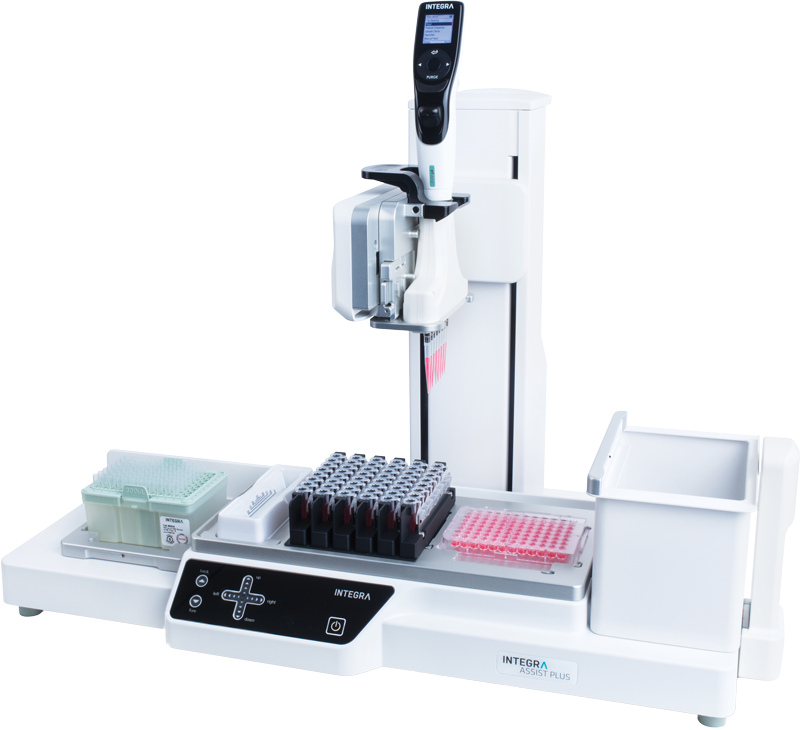
D-ONE Single Channel Pipetting Module, 0.5-300 µl
The D-ONE single channel pipetting module offers hands-free transfers from individual tubes or wells on the ASSIST PLUS pipetting robot. This makes it the perfect add-on for labs that want to go beyond the possibilities of multichannel pipetting to access unlimited applications. It is designed to offer easy automation of normalization, hit picking and master mix preparation, freeing up your time while eliminating transcription errors.
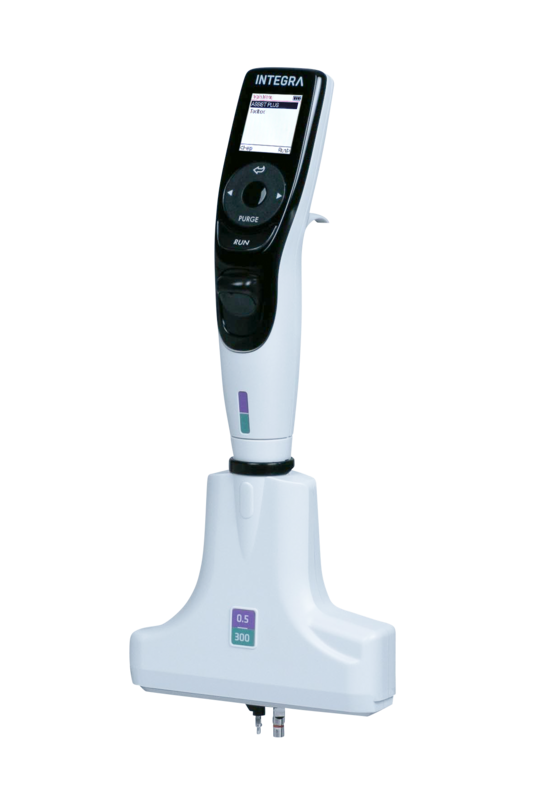
Tip deck for D-ONE on ASSIST PLUS
- Supports accommodation of 1 x 12.5 µl/ 125 µl tip box and 1 x 300 µl/ 1250 µl tip box
- Compatible with D-ONE Pipetting Module 0.5 - 300 µl and 5 - 1250 µl
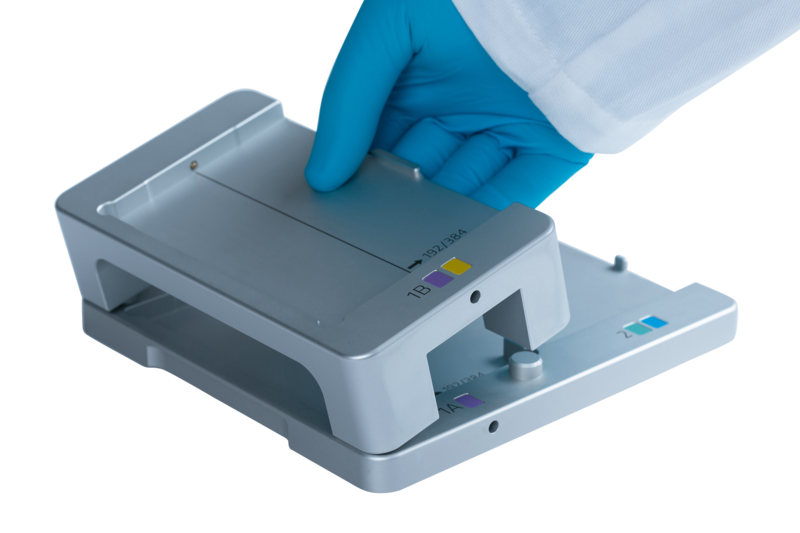
Rack for 1.5/2 ml microcentrifuge tubes
Hold up to 48 tubes on removable carriers for easy loading and storage.
Part No. 4540
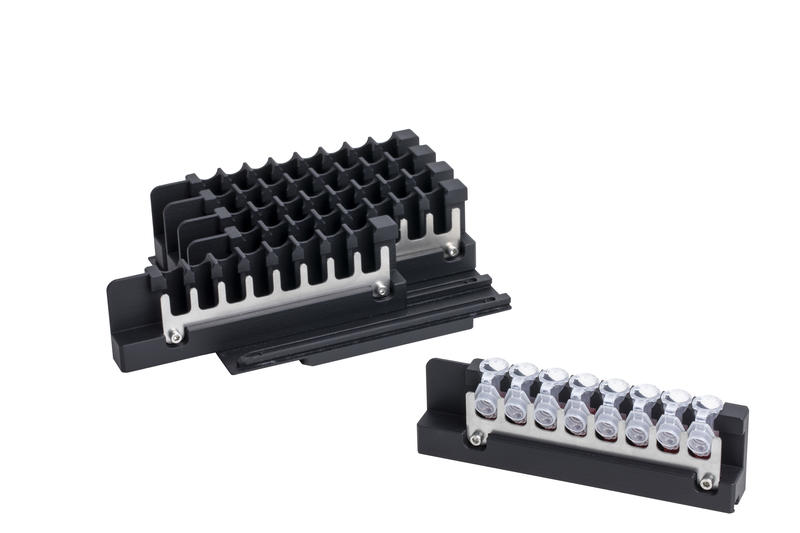
Reservoir Base, 25 ml
Holds disposable reservoir securely during use. One free base is included with every case of bulk or individually wrapped reservoirs.
Part No. 4304
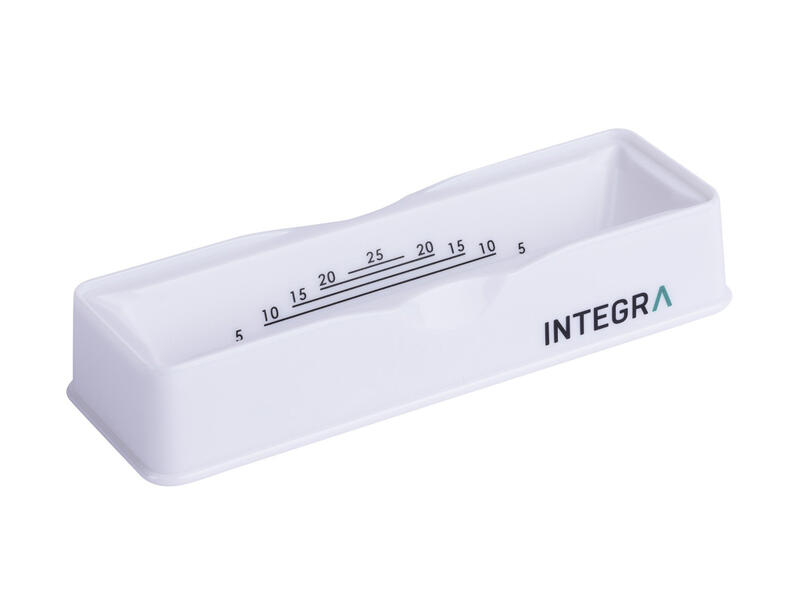
Multichannel Reagent Reservoir, 25 ml
- SureFlo™ anti-sealing array prevents pipette tip seal off which can cause liquid to pop into the tip, filter or even the pipette itself
- Unique surface treatment spreads liquid evenly offering even lower dead volumes
- Reusable base with bold, crisp, clearly visible graduation markings
- Nest inside each other, making it possible to get twice as many reservoirs in half the space of other products on the market
- Reducing inventory space requirements and shipping costs
- Available as crystal clear polystyrene reservoirs or polypropylene reservoirs for improved chemical compatibility
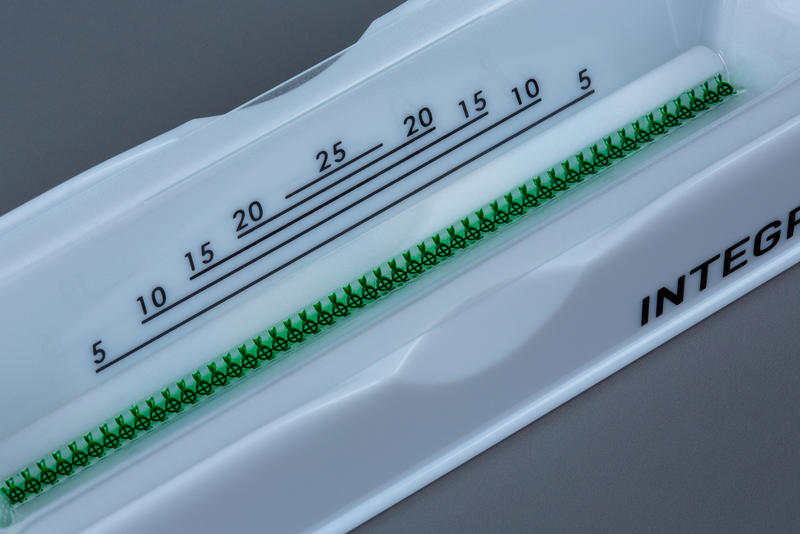
GRIPTIPS®, 12.5 µl LONG, Sterile, Filter (for automation systems)
GRIPTIPS® pipette tips perfectly match the multi-lobe tip fitting, snapping firmly on during loading. This guarantees a perfect seal on every tip, preventing them from loosening, leaking or completely falling off. All tips are precisely aligned horizontally, enabling accurate touch-offs, even when pipetting with 384 tips.
Part No. 6405
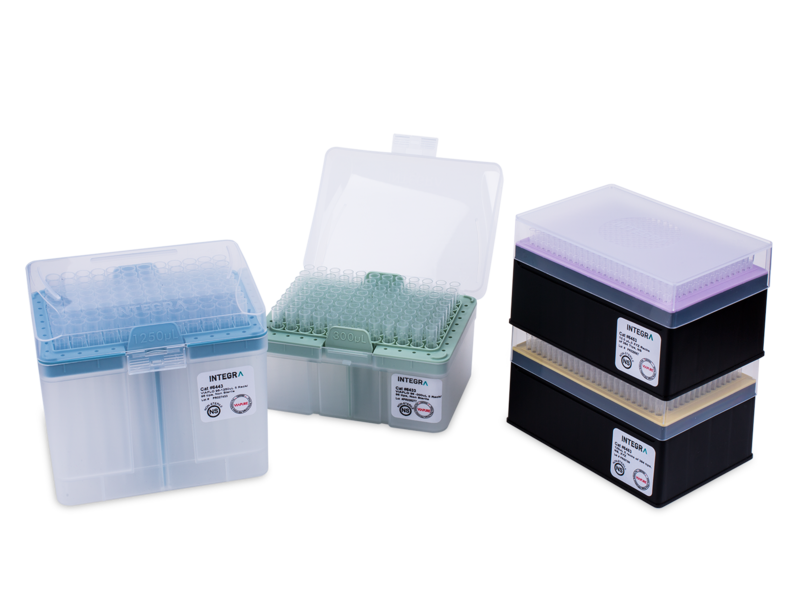
GRIPTIPS®, 300 µl, Sterile, Filter for 96 Channel Pipetting Heads
Precise and consistent tip seal ensures that all tips on a MINI 96, VIAFLO 96 and VIAFLO 384 are at an identical height for reliable touch offs and consistent pipetting results. An additional tip straightness inspection process ensures all pipette tips access wells even when dispensing to a 384 well plate.
- For use with 200 and 300µl INTEGRA pipettes and MINI 96, VIAFLO 96 and VIAFLO 384 pipetting heads
- Tip racks are reinforced to guarantee proper loading of the GRIPTIPS® each and every time
Part No. 6435
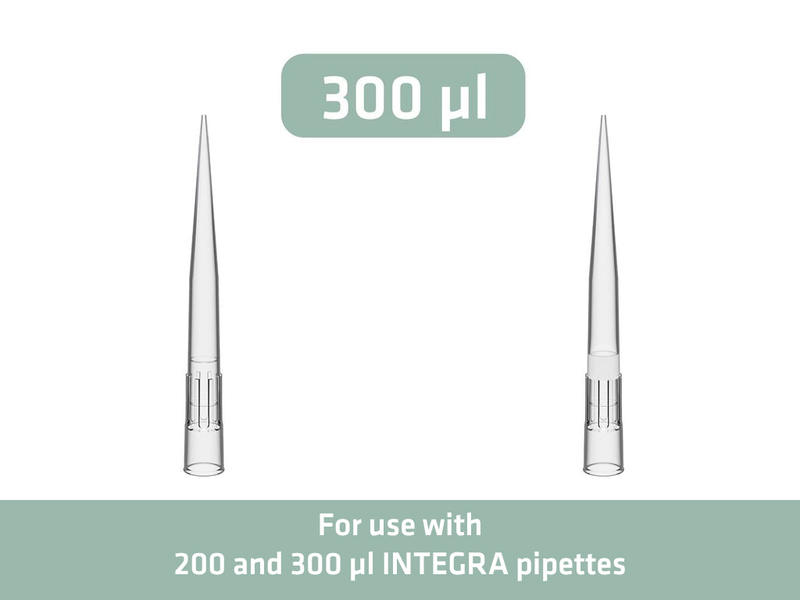
Waste Bags for ASSIST PLUS
Disposable waste bags for the tip waste bin to collect tip waste
Part No. 4570
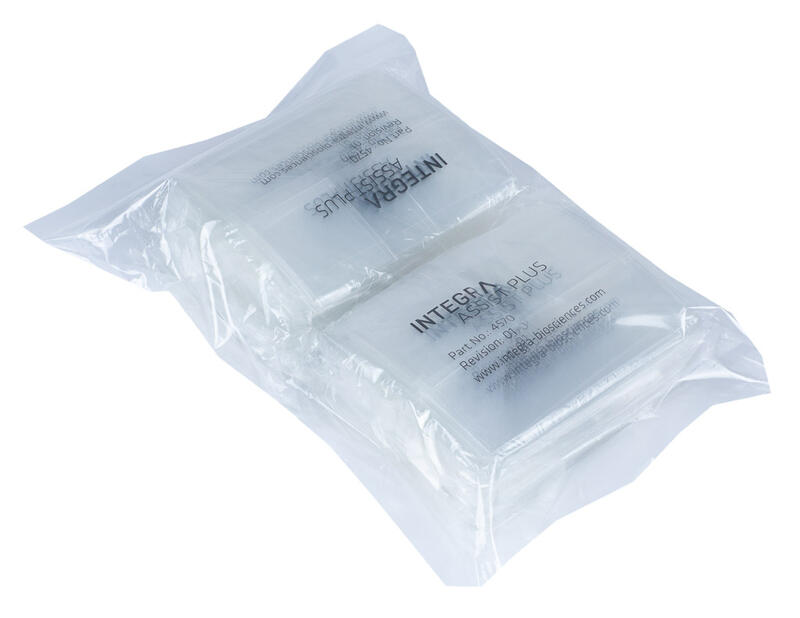
Bio-Techne: Simple Western Jess System
Jess automates the protein separation and immunodetection of traditional Western blotting, eliminating many of the tedious, error-prone steps. Just load your samples and reagents into the microplate and Jess separates your proteins by size, and precisely manages antibody additions, incubations, washes and even the detection steps. Come back to fully analyzed results in 3 hours. Go further with high sensitivity multiplexing—her best-in-class fluorescent detection channels and RePlexing capabilities get you all the information you need on your samples in one run. Jess automated western blot system—she's like multiplexed Western blot meets ELISA in one.
Source: Website Bio-Techne
Bio-Techne: HeLa Lysate Controls
Compatible with Jess™, Abby™, Wes™, Peggy Sue and Sally Sue systems.
Source: Website Bio-Techne
Novus Biologicals: C2C12 Whole Cell Lysate
C2C12 lysate was prepared by homogenization in modified RIPA buffer (150 mM sodium chloride, 50 mM Tris-HCl, pH 7.4, 1 mM ethylenediaminetetraacetic acid, 1 mM phenylmethylsulfonyl fluoride, 1% Triton X-100, 1% sodium deoxycholic acid, 0.1% sodium dodecylsulfate, 5 ug/ml of aprotinin, 5 ug/ml of leupeptin. Cell debris was removed by centrifugation. Protein concentration was determined with Bio-Rad protein assay. The C2C12 lysate was boiled for 5 min in 1 x SDS sample buffer (50 mM Tris-HCl pH 6.8, 12.5% glycerol, 1% sodium dodecylsulfate, 0.01% bromophenol blue) containing 50 mM DTT.
Source: Website Novus Biologicals
Bio-Techne: Erk 1 Primary Antibody for Size Assays
Erk 1 Rabbit Primary Antibody, 1X stock (1 mL) for use on Jess™, Abby™, Wes™, Peggy Sue and Sally Sue systems.
Source: Website Bio-Techne
Novus Biologicals: Beta-Actin Antibody
Actin makes up the most abundant protein in many eukaryotic cell types. It polymerizes to form microfilaments that have an array of functions, including regulating contractility, motility, cytokinesis, phagocytosis, adhesion, cell morphology, and providing structural support. At least six types of Actin, falling into three categories, exist in higher eukaryotes. The three types, separated based on isoelectric point, include alpha ( alpha -Skeletal, alpha -Cardiac, alpha -Smooth Muscle), beta ( beta -Non-muscle) and gamma (gamma -Smooth Muscle, gamma -non-muscle) isoforms. Non-muscle beta - and gamma -actin are also known as cytoplasmic actin.
Source: Website Novus Biologicals
Bio-Techne: HSP60 Antibody
Heat shock proteins (HSPs) are a family of highly conserved stress response proteins. Heat shock proteins function primarily as molecular chaperones by facilitating the folding of other cellular proteins, preventing protein aggregation or targeting improperly folded proteins to specific degradative pathways. HSPs are typically expressed at low levels under normal physiological conditions but are dramatically up-regulated in response to cellular stress. Heat Shock Protein 60 (HSP60), also known as Chaperonin 60 (CPN60), is a mitochondrial matrix protein belonging to a highly conserved family of molecular chaperone and stress response proteins. HSP60 plays a role in stabilizing and refolding proteins in response to heat-shock or other cellular stress. Full length human HSP60 is 98% identical to mouse and rat HSP60.
Source: Website Bio-Techne
Bio-Techne: 12-230 kDa Separation Module
Compatible with Jess™, Abby™ and Wes™ systems. Includes separation box with Capillary Cartridges, 12-230 kDa Pre-filled Plates (pre-filled with Separation Matrix 2, Stacking Matrix 2, Split Running Buffer 2 and Matrix Removal Buffer), Sample Buffer, Wash Buffer, plus Standard Pack 1 clamshell with DTT, FL Standard master mix with 29 kDa System Control protein. Compatible with Detection module - sold separately. Available sizings include 2x13 capillaries per cartridge (26 data points), 8x13 (104 data points), 2x25 (50 data points) and 8x25 (200 data points).
Source: Website Bio-Techne
Bio-Techne: 12-230 kDa Fluorescence Separation Module
Compatible with Jess™ systems. Includes separation box with Fluorescent Capillary Cartridges, 12-230kDa Pre-filled Plates (pre-filled with Separation Matrix 2, Stacking Matrix 2, Split Running Buffer 2 and Matrix Removal Buffer), Sample Buffer, Wash Buffer, plus Standard Pack 1 clamshell with DTT, FL Standard master mix with 29kDa System Control protein. Compatible with Detection module - sold separately.
Source: Website Bio-Techne
Bio-Techne: Anti-Rabbit Detection Module
Compatible with Jess™, Abby™, Wes™, Peggy Sue and Sally Sue systems. Module includes: Luminol-S, Peroxide, Antibody Diluent 2, Anti-Rabbit Secondary Antibody, Streptavidin-HRP.
Source: Website Bio-Techne
Bio-Techne: Anti-Rabbit IR Detection Module
Compatible with Jess™ systems ONLY. Module includes: Anti-Rabbit IR Secondary Antibody, Milk-Free Diluent and Streptavidin-NIR. Must be used with Fluorescence Separation Module - sold separately.
Source: Website Bio-Techne
Bio-Techne: Anti-Mouse NIR Detection Module
Compatible with Jess™ systems ONLY. Module includes: Anti-Mouse NIR Secondary Antibody, Milk-Free Diluent and Streptavidin-NIR. Must be used with Fluorescence Separation Module - sold separately.
Source: Website Bio-Techne
Bio-Techne: Total Protein Detection Module for Chemiluminescence based total protein assays
Compatible with Jess™, Abby™, Wes™, Peggy Sue and Sally Sue systems. The Total protein detection module for Chemiluminescence based total protein assays includes Luminol-S, Peroxide, Antibody Diluent 2, Total Protein Reconstitution Agent 2, Total Protein Streptavidin-HRP. Compatible with Separation module - sold separately.
Source: Website Bio-Techne
Bio-Techne: RePlex Module
Compatible with Jess™ and Abby™ systems ONLY. The RePlex Module provides all the reagents needed to remove primary and secondary antibodies in a RePlex assay with two immunoassays or immunoassay with Total Protein assay in a single run.
Source: Website Bio-Techne
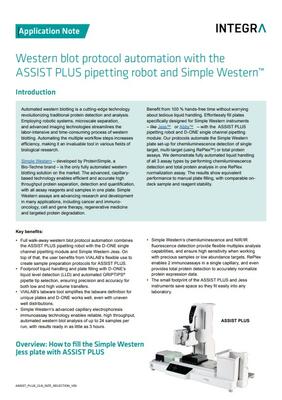
Downloads
Download App Note as PDF
DownloadWestern blot protocol automation with the ASSIST PLUS pipetting robot and Simple Western™Customer’s voice
From ddPCR, to ELISAs and sample normalization for HPLC, CE-SDS and cell based assay useage, we use the ASSIST in our lab daily. We have 6 across our three labs. They are always reliable, accurate, easy to use, and have a very wide range of applications. In addition to freeing up analysts to perform other work, they have decreased assay variation across multiple assays and users in our labs, for more reliable results with more impactful data! The team at INTEGRA is always willing to help with programming, and is very good at listening to feedback in terms of new accessories and software updates. We are very happy with them!

